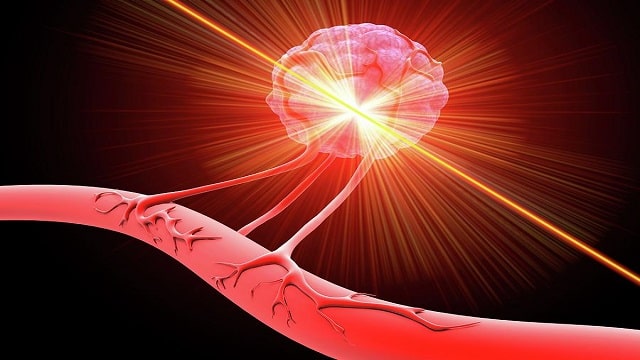Angiosarcoma (Blood Vessel Cancer)
Angiosarcoma is a rare type of cancer that develops in the inner lining of blood vessels and lymph vessels. It can occur anywhere but is most common in the skin, breast, liver, and spleen.
Symptoms of Angiosarcoma
Symptoms of angiosarcoma can vary depending on where the cancer occurs. When angiosarcoma affects the skin, it is more common on the head and neck and may cause:
- A raised area of skin that looks like a bruise.
- Bruise-like lesions that grow larger over time.
- Lesions that may bleed when scratched or bumped.
- Swelling of the skin around the lesion.
Meanwhile, if angiosarcoma occurs in organs such as the liver or heart, it often causes pain in those specific organs.
Causes of Angiosarcoma
So far, there is no further and specific explanation about what causes angiosarcoma. Angiosarcoma occurs when cells in the lining of blood vessels or lymph vessels experience changes in their deoxyribonucleic acid (DNA)
A cell’s DNA contains instructions that tell the cell what to do. These changes, or mutations, cause cells to multiply rapidly. Mutations keep cells alive when they should be dead.
As a result, there is a buildup of cancer cells that can grow outside the blood vessels or lymph vessels. Cancer cells can attack and destroy healthy body tissue. At some point, cancer cells can break off and spread to other areas of the body.
Angiosarcoma Risk Factors
Although the exact cause is not yet known, certain factors can increase the risk of developing angiosarcoma, for example:
1. Radiation therapy
Radiation treatment for cancer or other conditions can increase the risk of angiosarcoma. This disease occurs as a side effect of radiation therapy.
2. Swelling due to damage to lymph vessels
This swelling is called lymphedema. Lymphedema occurs when the lymphatic system is blocked or damaged. Lymphedema can occur when lymph nodes are removed during surgery. This is often done during surgery to treat cancer or other infectious conditions.
3. Exposure to chemicals
This disease can also occur as a result of exposure to chemicals. Examples of these chemicals include vinyl chloride and arsenic.
4. Genetic syndrome
Certain genetic changes present at birth may increase the risk of angiosarcoma. Examples include changes in the genes that cause neurofibromatosis, Maffucci syndrome, or Klippel-Trenaunay syndrome, and the BRCA1 and BRCA2 genes.
Diagnosis of Angiosarcoma
Less specific symptoms make this disease require a special diagnosis. There are several tests that must be done to find out the exact symptoms of angiosarcoma, namely:
1. Physical examination
The doctor will conduct a thorough examination to determine your health condition.
2. Sampling
A sample is taken for tissue testing. This procedure is called a biopsy. This test can detect cancer cells.
3. Imaging tests
Imaging tests can give your doctor information about the severity of your cancer. Imaging tests can be done with several alternative options, starting from magnetic resonance imaging (MRI), computed tomography scan (CT scan), or positron emission tomography (PET). The test that will be chosen depends on the condition of the cancer and the doctor’s recommendation.
Angiosarcoma Treatment
The treatment chosen depends on the condition and severity. Some treatment options include:
1. Operation
The goal of surgery is to remove all of the angiosarcoma. The surgeon will remove the cancer and some of the healthy tissue surrounding it.
2. Radiation therapy
Radiation therapy uses high-energy rays, such as X-rays and protons, to kill cancer cells. Radiation therapy is sometimes used after surgery to kill any remaining cancer cells. Radiation therapy may also be an option if you cannot have surgery because the cancer has spread too far.
3. Chemotherapy
Chemotherapy is a treatment that uses drugs or chemicals to kill cancer cells. Chemotherapy may be an option if the disease has spread to other areas of the body. Sometimes chemotherapy can be combined with radiation therapy if surgery is not an option.
4. Targeted drug therapy
Targeted drug treatments attack specific chemicals inside cancer cells. By blocking these chemicals, targeted drug treatments can cause cancer cells to die. For this treatment, targeted drugs may be an option if the cancer is already in an advanced stage.
5. Immunotherapy
Immunotherapy uses the body’s immune system to fight cancer. The immune system may not attack the cancer because cancer cells make proteins that help them hide from immune system cells.
Immunotherapy works by interfering with this process. For angiosarcoma, immunotherapy may be a treatment option for advanced cancer.
Angiosarcoma Complications
Angiosarcoma can spread very quickly because it starts in the blood vessels. Once it spreads, it is very difficult to treat. Although doctors have effective ways to treat angiosarcoma, only about 35 percent of people with it survive. The chance of survival is about five years from the time angiosarcoma is first diagnosed.
Angiosarcoma Prevention
Avoiding certain activities can prevent angiosarcoma. For example, providing skin protection from sunburn, or limiting the use of certain chemical products.
Angiosarcoma can sometimes run in families. People with a change in a gene called POT1 can develop cardiac angiosarcoma, and this change can be passed on to their children. Of course, if it is caused by a genetic condition, angiosarcoma cannot be prevented.
When to See a Doctor?
You need to see a doctor immediately if you experience some of the symptoms mentioned above. Given that angiosarcoma can spread very quickly, you need to get tested immediately if you suspect you have a certain cancer.
